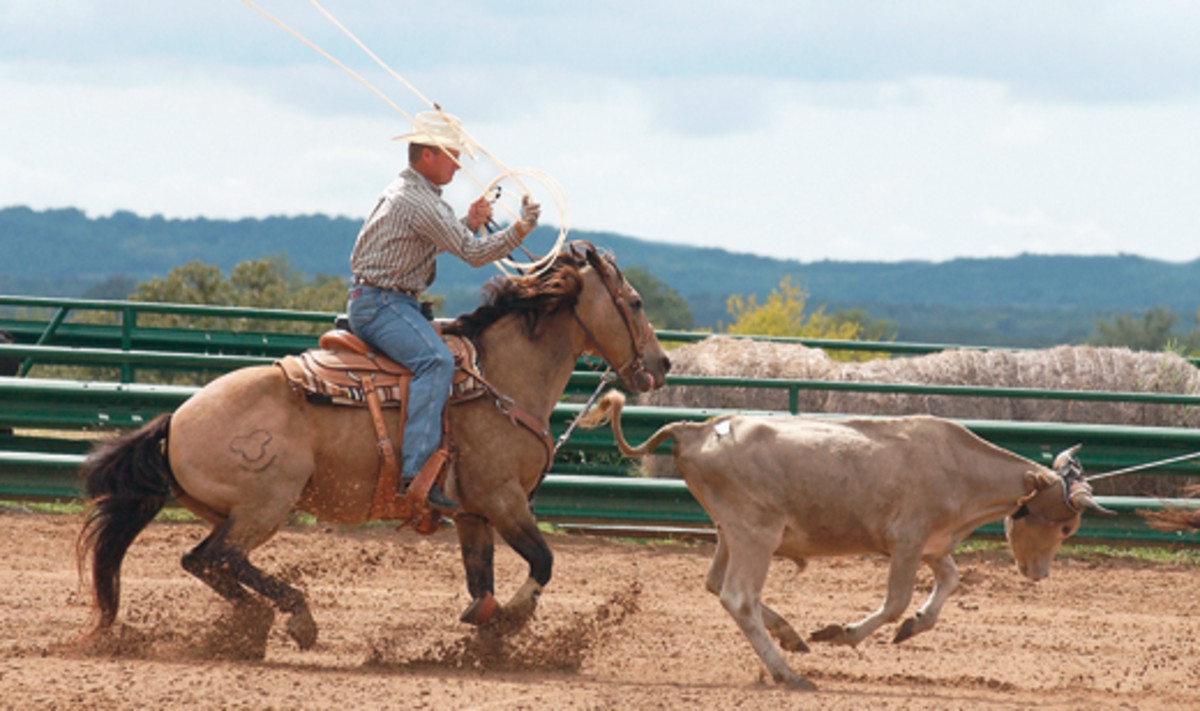There came a time when I began to realize that my roping ability was good enough to compete with the best ropers in the world. That’s when I needed a lot of work on my riding, and needed to work on the ability to control things and get myself into position in the different scenarios of competition. And that’s when I started paying attention to the importance of my left hand when I ride and rope

Getting the right position every time allows you to do whatever it takes to win in each situation, whether you need to be fast or just get a steer caught. Regardless of the circumstances, I find that if I get in the right position I hardly ever miss.

I had to isolate that area early on when I started rodeoing professionally. It didn’t come into play as much at that time jackpotting, because back then if you caught two feet every time you won. When you don’t have to be really quick but still need to be consistent it’s not as important, because you have time to wait it out until a good shot presents itself. When you have to be fast, you have to be more of a marksman with your horsemanship to get that perfect position every time.

To get that position, I had to isolate my left hand to be aware of how I was controlling my horse. It’s easy just to blank out and not pay attention to details like your left hand. But it can’t be overlooked.

Each horse is different in his mouth, how he goes down the arena, how much more left rein you need on this one or that one, how each horse scores, how fast he runs, etc.… So you need to be conscious about which bridle and reins you use on each horse. I want my setup on each horse to give me the maximum communication and the right feel.

When you’re getting down to precision, the way you set your equipment up is even more precise than usual. I bet I’ve got at least 20 bits, and every one of them is different.

These days, I work hard not to overreact with my left hand. I have to be careful about that or I’ll drop my horse in there too early or hold him out too late. I’m learning to trust in my horse and let him react to the steer turning, rather than overreacting myself. I want a pattern of allowing him to react, while I’m staying steady and in control with my left hand at the same time. Racecar drivers are similar. If they over-
react, they’ll wreck.

Riding some new horses this year made me really examine my horses, and pay attention to what works best for each of them with my left hand. I had to work with them to figure out what cues work best for each of them. I tried a bunch of things on Scout, the sorrel horse, I rode earlier in the year, like riding tight to the steer, wide to the steer, using different bits and tiedowns. I kept tweaking and trying to find what was going to work best. It was a process, because the horse was green. What saved me is he has such a good mind and mouth.

I bought another horse (Sport) that I started riding at Oakdale (Calif.). He’s pretty much automatic. He runs strong in the bridle and doesn’t have a whole lot of whoa, but he uses his butt and slides when he stops. I had to learn to trust him and completely turn him loose. (Clay’s Ike shown here.)They’re completely different horses, but I can get maximum performance from each horse if I do what each one needs consistently. From the stands it might be hard to notice the difference in the way I ride them if it wasn’t pointed out to you. The differences are subtle. But to me, there’s a big difference in how I ride each horse.The main point here is that horsemanship is key to being a good roper, and the relationship between you and your horse is communicated mostly with your left hand.

I don’t want to make things more complicated than they have to be, but you do need to mold yourself to what each horse needs. One needs to be taken ahold of more, one needs to be held out wider, etc.… There are a lot of little variances that go with each horse in order to help him hit that magic spot time and time again. This is not a one-size-fits-all deal. Each person needs to find his own way with each horse. There’s a relationshipbetween every rider and horse that develops into a pattern that works.

Some of the Top-15 guys sometimes trade out rides when we practice, so we’ll know each other’s horses if we need to get on them. At first it feels foreign, but after a few runs you learn what you need to do to get along with each horse.

People who are too heavy-handed and make big moves with their left hand have more problems with position than guys that are soft-handed and make smaller moves. When I get on a strange horse at a rodeo I’d rather let loose and trust him, because he doesn’t know me. I’m better off to let him work and react to what he does, rather than try to force him to do what I want.

Guys with a soft, steady left hand are much more impressive to me. They’re the guys with the good horses. Guys who are heavy-handed and harsh with their left-hand movements have trouble keeping their horses working. Pay attention to your left hand when you practice, and if the truth hurts change it.










